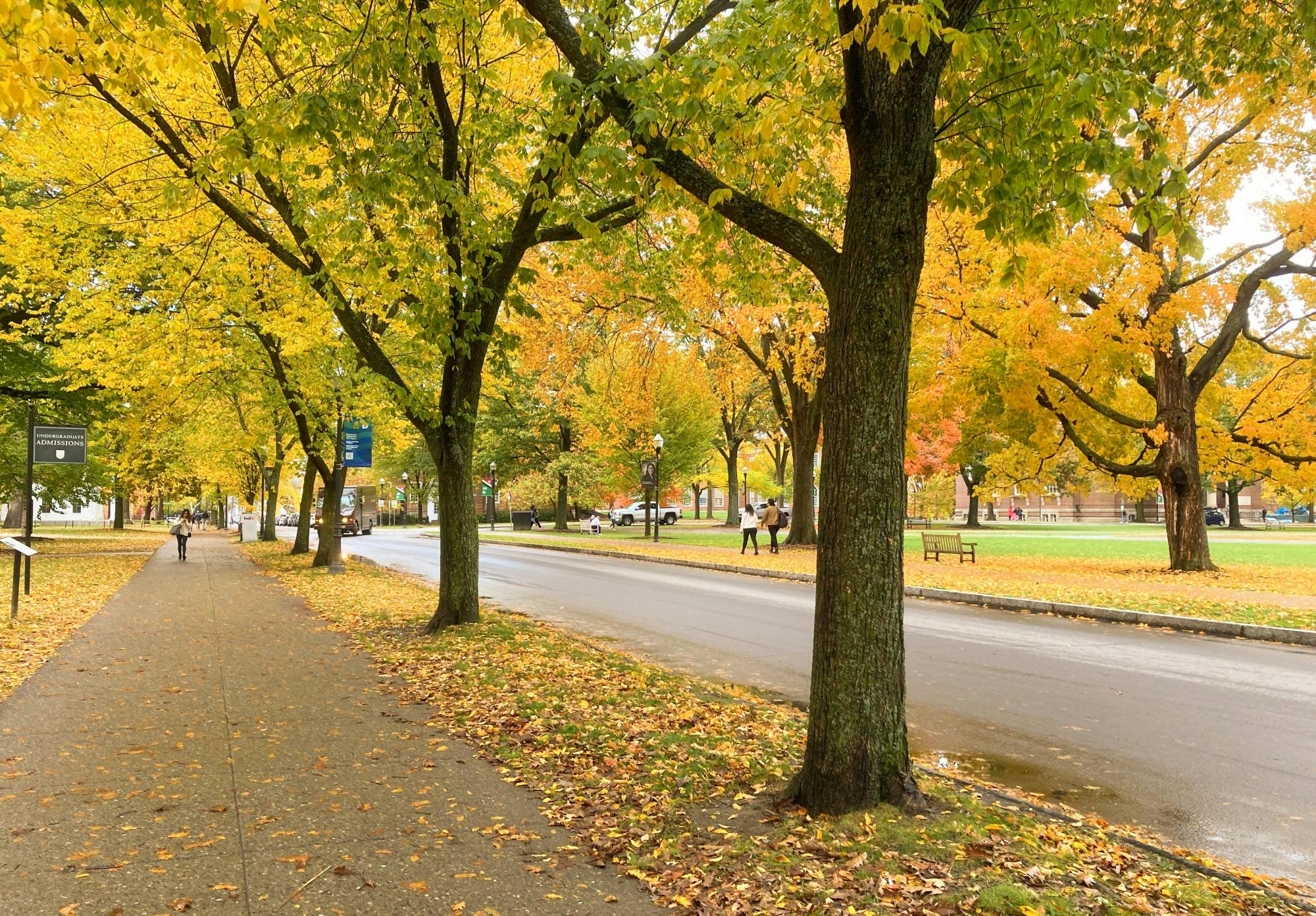As fall foliage season nears, Dartmouth students and Hanover businesses are preparing for an increase in tourism over the next few weeks. Foliage is expected to peak in the Dartmouth-Lake Sunapee region between Oct. 5 and Oct. 15, according to the New Hampshire Division of Travel and Tourism’s website. As of Sept. 27, only 10 to 15% of the leaves have changed color, though more colors are expected to arrive in the coming weeks.
According to biological sciences professor Caitlin Hicks Pries, leaves change color in the fall in response to temperature drops during the night. Cooler nights in late September and early October cause leaves to stop producing chlorophyll, the pigment that usually makes them green.
“Chlorophyll is what [makes leaves] green, and then the underlying colors of the leaves are revealed.” she said. “Those are oftentimes yellows to oranges.”
Hicks Pries added that red colors only appear when the tree produces anthocyanins — pigments that protect leaves from UV rays. Red leaves, which are often found on different types of maple trees, are less common than yellow and orange varieties and are highly sought after by leaf-peepers, she said.
According to Hicks Pries, the large amount of rainfall from this past summer may affect the vibrancy of the leaves. She added that although warming temperatures due to climate change may delay peak foliage, the effect of global warming on the vibrancy of leaves still remains unclear.
“I think it’s just not going to be as bright this year,” she said. “The plants were stressed by a very wet summer.”
According to New Hampshire Travel and Tourism director Lori Harnois, the state is expecting almost 3.5 million visitors who will generate around $1.7 billion during fall foliage. This year’s revenue predictions are similar to those generated by tourists last year, which marked a return to pre-pandemic levels, she said.
“After coming off the pandemic, we saw record-breaking years, [as] there was lots of pent up demand,” Harnois said. “We had two great years, and now we’re starting to see things level off.”
In 2022, the Dartmouth-Lake Sunapee region hosted 345,800 visitors during the fall who spent about $93.9 million, Harnois said. Typically, fall foliage travelers visit New Hampshire by motor coaches, starting in mid-September and lasting through the end of October, according to Harnois.
“Fall for New Hampshire is actually the second busiest travel season, [only] to the summer,” she said.
Bryan Smith, owner of Records, Posters and Memorabilia New Hampshire, said the rise of Hanover-area fall foliage bus tours has contributed to his sales in recent years. He added that many tourists drive through Hanover to visit Dartmouth’s campus, stopping at his store en route.
“In the last two years we have been able to get buses through town,” Smith said. “I get a lot of record collectors from the buses.”
Clara Boland, the front-of-house manager at The Nest Kitchen and Cafe, attributes a “huge spike” in business to the return of Dartmouth students to campus, along with an increase in tourism during peak foliage. Family Weekend and Homecoming weekend are also sources of increased business for The Nest, according to Boland.
“I’d probably say a little bit of business is tourism around fall foliage, but mostly Dartmouth coming back is our biggest boom in business,” she said.
Every fall, Cabin and Trail, a Dartmouth Outing Club sub-club, leads trips and activities centered around fall foliage. According to CnT chair Solange Acosta-Rodriguez ’24, some of the most popular activities are sunrikes, or sunrise hikes, which are conducted almost every day during peak foliage.
According to Acosta-Rodriguez, Gile Mountain and Mount Cardigan are “classic” hikes for peak foliage observers. She added that hikes in the White Mountains are some of her favorites for observing colorful leaves.
“You’re just walking for miles on the ridgeline, and you have a 360 view of the leaves,” she said.
According to Acosta-Rodriguez, students sign up almost “automatically” for hikes and other activities when peak foliage appears in the name of the outing. To compensate for an uptick in participation, CnT leaders have increased the number of hikes to around three per week during peak foliage, added Acosta-Rodriguez.
Joy Yan ’27 said that she experienced the changing colors while hiking Gile Mountain over family weekend.
“The trees in Hanover are still green-ish [with] some orange, but on my Gile hike it was completely different,” she said.
Ultimately, Acosta-Rodriguez hopes that more Dartmouth students will be able to spend time outside to observe the colorful foliage this fall.
“Go outside, appreciate it,” she said. “It’s special.”

My name is Sierra Sugarman '27, and I am from Pacific Palisades, California. At Dartmouth, I am majoring in Quantitative Social Science. In addition to writing for The D, I am involved with Dartmouth Consulting Group, Dartmouth Center for Social Impact, First-Year Trips, and Jewish groups on campus. I love doing practically anything at the beach, traveling, and spending time with friends.




